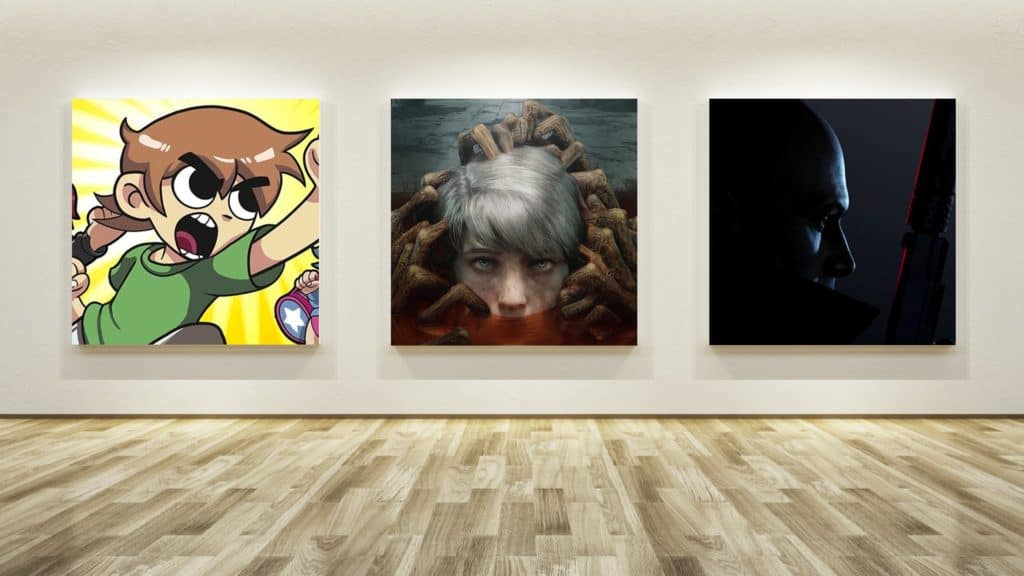Video Gamer is reader-supported. When you buy through links on our site, we may earn an affiliate commission. Prices subject to change. Learn more
Each month, we invite élite art critic Braithwaite Merriweather to appraise the box art of the latest game releases. In between his time spent wandering the corridors of culture, Merriweather writes on a freelance basis for various publications, including Snitters and Nuneaton à la Carte. If you are unaware of his prowess, rest assured; he’s on a crusade to educate the unwashed. Put simply, he’s a man that needs no introduction.
After my absence at the family oubliette for Christmas dinner, and in the face-off continuing lockdown, I have been roped into a concatenation of drab cyber-conversations, via the infernal service known as “Zoom.” The company responsible for this horror resembles a cut-price parody of Prometheus—handing to man not fire but the pixelated image of fire, cold to the touch. These last two weeks, the faces of my siblings and parents have been crammed into their little digital frames, blurred now and then by the cough and crackle of tightening bandwidth. It’s as though I have been hosting a little digital gallery of dreary and disapproving self-portraits. Right this moment, as they babble, like an electronic brook, amongst themselves, I am secretively glancing at this month’s crop, dropping in the odd noise of approval to convince them of my presence. But I am elsewhere.
Hitman III

This gentleman, with his smoothly razored scalp, his raised collar and pistol, and his side-on pose—as though someone may care to stamp him onto a coin—reminds me of death. The artist behind this work, which is entitled “Hitman III,” understands the ambiguous power of undiluted darkness. Of all things, it brings to mind “Self Portrait with Bandaged Ear” (1889), by Van Gogh, who understood the ambiguous power of undiluted brightness. (My ex-wife, on the other hand, understands only the undiluted power of money.) Regardless, this work has left me feeling strangely morbid, yet hopeful—like emerging from the hospital in flinty health. It isn’t often that a work so sparse and gloomy leaves me with room to ruminate, especially one with such plainly commercial appeal—the gun, the half-turned brooder. You can imagine this work selling, like hot cakes, to the masses and hanging on a million walls. It may as well have a barcode stamped on it.
The Medium

The history of hands on faces, in art, is rich in fear and fret. Think of “Self-Portrait, One Hand Touching the Face” (1918/19), by Oskar Kokoschka, depicting a man nibbling nervously at his fingertips. Or, indeed, of “The Scream” (1893), by Edvard Munch, whose spectre of a subject claws at its cheeks in terror. (A similar expression befall that of my sculpture tutor at Hildebrand-Rothchild St John-Benson-Brandruthson institute of fine, contemporary, and experimental art, Dr Jøhannes Wolfraüger, when I presented him with my thesis piece: it is a look of shock and ecstacy, touched by afflatus.) The artist behind this new work, “The Medium,” has paid homage to this legacy, by, on the one hand, putting a finger on the anxiety that wrings through it; and, on the other, thumbing his nose at the restraint of those earlier works. This poor woman, nose-deep in a puddle of rusty red, is being grabbed and scratched by a forest of gnarled fingers.
I know the feeling! Not only have I fended off the efforts of my ex-wife and her solicitor—whose greedy mitts were grasping at every square inch of my finances, threatening to pull me into the dirty pool of insolvency! But also have I battled the council’s attempts at extracting remuneration for a bushel of trumped-up zoning infractions (the price of a decent pavement gallery, apparently). This work (much like my ex-wife) leaves me cold. As ever, one must appreciate the warm hum of homage wherever one sees it, but what else? Box art cannot only look back; it must have its feet in two worlds—then and now, death and life—it must be a conduit, through which the voices of the past gather, like a committee of ghosts, and whisper their wisdom into the ears of the living. When I gaze at “The Medium”—as when I venture into the Courtauld Gallery—I see very few signs of life.
Scott Pilgrim vs. the World: The Game—Complete Edition

It isn’t often that a work is so utterly bereft of ideas and life that it drags against one’s soul like a serrated blade; that it plugs up the nostrils of one’s mind like psychic snot; that it delivers a bracing punch to the emotional diaphragm, knocking the breath from your very being; that its lack of contribution to the art, and to the human experiment, actually forms a kind of solid emptiness; that you feel the need, after scraping your irises across the canvas, to rinse them with Clorox; that one considers—rather than attempting to delve into its depthless abyss and resurface with the slightest scrap of matter to bring to one’s readers—going back to the laptop and surrounding oneself with the inane and garbled blather of blood relatives, just to find the merest semblance of humanity—albeit one scumbled by the inefficient fibre-optic cables of TalkTalk, with its false promises and, given the recent connectivity problems, its bitterly ironic name.
